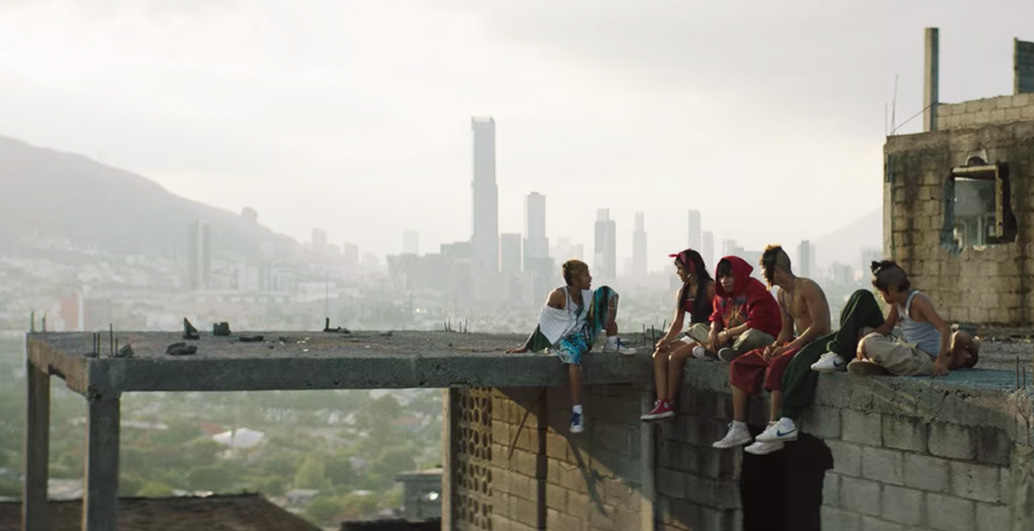With flashy dance moves and even flashier hairstyles, the Cholombiano street culture of Monterrey, Mexico exists at a cultural crossroads. Patterns of migration and commerce have brought together this subculture’s preferred genre of Colombian cumbia, the laggy mixes of Mexico City’s sonidero DJ style and the oversized garments of West Coast cholo fashion into this northeastern Mexican city.
It is in Monterrey where sounds and culture which have captivated the rest of Latin America have risen up from. The Avanzada Regia movement which took over Monterrey during the mid 90s laid out a blueprint for electronica, alternative rock and hip hop in Spanish to spread into the Spanish-speaking mainstream, at home and abroad. The corrido tumbado movement, currently setting Mexican regional stations ablaze, might riff closer to Sinaloa and Sonora-style folk ballads, but draws its core from German polka and Texano influence hailing from Monterrey over a century ago.
But unlike the many popular sounds and trends which spawned in this city, the cholombiano way of life remained contained in the city’s marginalized communities. In Ya No Estoy Aquí (I’m No Longer Here) we are treated to an exploration of place and belonging through the experience of Ulises Samperio (Juan Daniel Garcia), a cholombiano displaced from the his home in the middle of an intensifying turf war triggered by the Mexican war on drugs of the 2010s.
The 17-year-old Ulises hails from the wrong side of the tracks, among the steep hills and makeshift cinder block structures on Monterrey’s outskirts. At home, his family life is broken down. His single mother scolds him for playing the radio too loud and his baby brother is constantly crying, unable to be put to sleep because of Ulises’ tunes. Around him, new gangs have come into the community and there are no prospects for anyone looking to play it straight.

Out among his peers however, Ulises is king. He leads Los Terkos, a dance crew that spends its days and nights jamming to half-tempo cumbia remixes with other Cholombiano teenagers. At parties full of extravagant styles, his flair and dance moves make him stand out above the rest. Older gang members show Ulises respect and ask him to keep his friends out of trouble. Girls crowd around to get a picture with him while the homies say he is famous with pride in their voice.
But Ulises is no longer on top of the world upon his arrival to the Jackson Heights community of Queens, New York. He is regularly pushed around and made fun of by his new roommates, older day laborers who roam the neighborhood looking for jobs. His appearance draws comments comparing him to a Dragon Ball Z character. They call Ulises a homophobic slur when he refuses to dance to boisterous banda sinaloense music — associated with the intensifying narco culture back home — with an older woman at a nightclub. After enough abuse, Ulises fights back and is left to fend for himself on the streets.
I’m No Longer Here moves between the past and present, showing us what life used to be like in Monterrey for Ulises and his current struggles in New York. Melancholy flashbacks are set to cumbia lyrics expressing a longing for the hills and grassy clearances back home. The songs were originally written about Colombia’s countryside, but convey the same longing for a distant Monterrey. These flashbacks come in the middle of sleepless nights, as subway carts zoom by his window.

Ulises begins to catch a break when Lin (Angelina Chen), the 16-year-old granddaughter of a shopkeeper in the building he is squatting in, becomes interested in his style. Despite Lin’s compassion — made all the more laudable given their language barrier — Ulises begins to feel smothered by Lin and increasingly feels out of place. At a lively house party they attend together, Ulises runs away; he hates the music and he has no one to really speak to. He still dreams of Monterrey.
Times have changed back home by the time Ulises is deported to Mexico shortly afterward, now with a plain head of hair. A new government administration has fumbled its response against the rise of powerful cartels, leading to increased militarization throughout. Isai, a member of the Los Terkos crew, is being buried the day Ulises returns as one more casualty from the drug wars. Ulises has returned to his old neighborhood, which now has nothing for him to return to.

The film closes with a shot of Ulises dancing by himself, with Monterrey’s city core and luxurious towers off in the distance. He is a young man who finds himself without a place, a present or a future.
In a previous conversation with the author, director Fernando Frías de la Parra likened the film’s decelerated cumbias to making one’s glory days feel a little bit longer. “Maybe a cumbia is five minutes long, but when you slow it down to 15 minutes it’s a way of having it play and not end. There is nothing left after that song stops playing,” he remarked.
I’m No Longer Here is now streaming on Netflix.







